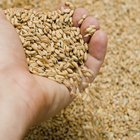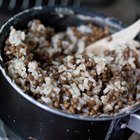
Plain white rice in its various incarnations is a supremely versatile ingredient or a useful side dish in its own right. Its only real drawback is that much of its nutritional value was milled away along with its husk. Health-conscious diners are more likely to gravitate to the whole-grain virtues of brown rice, or to the high-protein nutrition of pseudograins such as quinoa. A rice maker will cook either of those alternatives just as well as white rice, either separately or together.
White Rice vs. Brown Rice
White rice is an immediately familiar part of many meals, from the impossibly light and fluffy basmati of your favorite Indian restaurant to the dense and chewy short-grain rice in your sushi roll. In any variety of white rice, the fibrous bran and vitamin-rich germ has been milled away to give the grain its mild flavor and and attractively white appearance. Brown rice and other colored rices retain their bran and germ. They take longer to cook, because the bran layer slows their absorption of water, but these rices have a chewier texture and are much more nutritious.
Seeds of Time
Quinoa is one of a group of grains and pseudograins referred to collectively as "ancient grains" for marketing purposes. Once, quinoa was the staple of the Incan empire, a crop that produced prolifically even in the poor soil and harsh climate of the Andes. It was suppressed by the Spanish, but began to make a comeback in the 1980s as food scientists recognized its potential as a modern food crop. The tiny seeds are low in carbohydrates and high in complete protein, containing all the essential amino acids. That means vegetarians don't need to combine it with legumes for proper nutrition.
Brown Rice and Quinoa Together
Either brown rice or quinoa will cook perfectly well in a rice cooker, with the rice taking approximately 45 minutes and quinoa taking 15 minutes. This difference in cooking times would seem to argue against cooking them together, but the combination is surprisingly effective. The quinoa cooks away to a soft and creamy texture, giving the otherwise dry and chewy brown rice a pleasantly creamy coating that adds moisture and a nutty flavor to the rice. The sauce-like effect can be enhanced by sauteing the quinoa briefly with onions and herbs before adding it to your rice cooker.
Alternative Methods
If you'd rather keep your quinoa intact, so you can enjoy the distinct flavors and textures of each grain, there are a few alternative methods. The most reliable is to cook them separately, keeping the rice warm during the quinoa's brief cooking time. Alternatively, you can prepare the quinoa ahead of time, and sprinkle it on top of the rice at the end of its cooking cycle. The steam rising from the cooked rice during the keep-warm cycle will heat the quinoa completely within five to 10 minutes. Stir them together before serving, or toss them in a serving bowl until they're combined.
Related Articles

How to Cook With Kamut

How to Cook Brown Basmati Rice

How Does Measuring Dry Quinoa Compare ...
Toppings for Quinoa

What Is White Oat?
Difference Between Short-Grain & ...

How Long Do I Cook Vermicelli?

How to Cook Long Grain Rice

How to Make Bread Flour

Can I Freeze Wheat Berries?

Rice & Lentil Diet
How to Cook Volcano Rice

Does Rice Taste Different Depending on ...

Is Jasmine Rice Naturally White or Is ...

How to Cook Red Camargue Rice

Alternative Flours to Make Pizza

Differences Between Steamed & Boiled ...

Difference Between Red Rice & Brown Rice

Bulgar Wheat Vs. Couscous
How to Substitute Quinoa for Breadcrumbs
References
- The Kitchn: Quick Tip -- Try Mixing Grains
- Chicago Tribune: A Beautiful Medley
- Williams-Sonoma: How to Cook Whole Grains in a Rice Cooker
- On Food and Cooking: The Science and Lore of the Kitchen; Harold McGee
Writer Bio
Fred Decker is a trained chef and prolific freelance writer. In previous careers, he sold insurance and mutual funds, and was a longtime retailer. He was educated at Memorial University of Newfoundland and the Northern Alberta Institute of Technology. His articles have appeared on numerous home and garden sites including GoneOutdoors, TheNest and eHow.
Photo Credits
Eising/Photodisc/Getty Images